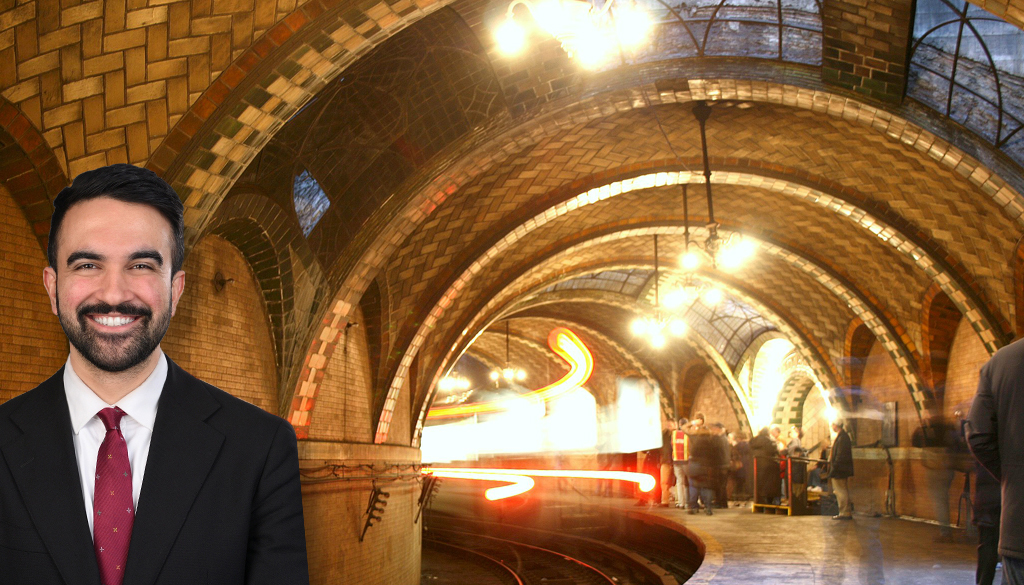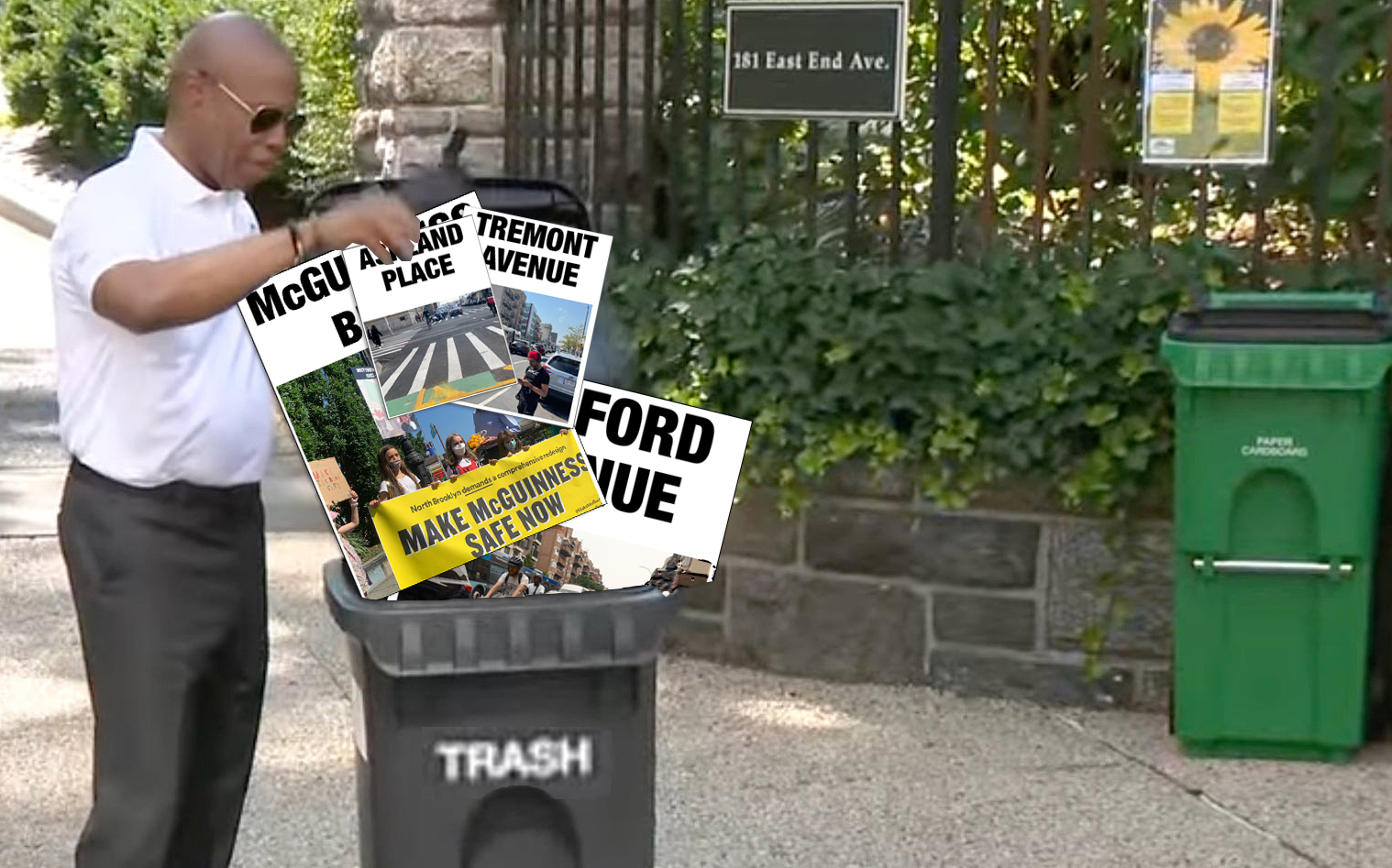There is probably no more beloved figure in urbanism than Jane Jacobs, who fought to preserve some of New York City's most treasured neighborhoods and who gave urbanists some of the field's fundamental texts. As Ed Glaeser notes in the New Republic this week, Jacobs died in 2006 "a cherished, almost saintly figure," while her principal antagonist, Robert Moses, remains popularly reviled as a villain.
 Jane Jacobs (center, in light dress) demonstrates at New York City's old Penn Station. Photo: Metropolis
Jane Jacobs (center, in light dress) demonstrates at New York City's old Penn Station. Photo: MetropolisBut as American cities have outgrown their infrastructure in recent decades, and as political institutions have proven unable to muster the energy necessary to construct great projects, Moses' reputation has enjoyed something of a recovery. Increasingly, he is being actively rehabilitated in new histories and essays, of which Glaeser's review is an example.
These efforts are interesting because they manage to earn a degree of sympathy from urbanists themselves, who have grown increasingly tired of the decades required to navigate a transit line from planning stages to operation.
There is something very attractive about an individual who can drive the stakes and get the project built -- damn the politicians, and damn the NIMBYs.
But this is dangerous territory. In rehabilitating Moses and reconsidering Jacobs, it's important to be clear about where each was right, and where each went wrong.
There are many ways to interpret the clash between Moses and Jacobs: development versus preservation, city versus suburb, design for people versus design for automobiles, power versus powerlessness, and so on. To acknowledge that the balance has swung too far in one direction in one of these conflicts does not at all suggest that the balances are similarly out of whack on others.
Take, for example, one of Glaeser's principal intellectual standbys: that resistance to development slows the growth of housing supply, increasing housing costs. Glaeser says:
Jacobs underestimated the value of new construction—of building up.
The Death and Life of Great American Cities argues that atleast one hundred homes per acre are necessary to support excitingstores and restaurants, but that two hundred homes per acre is a“danger mark.” After that point of roughly six-story buildings, Jacobsthought that neighborhoods risked sterile standardization. (The onepublic housing project that Jacobs blessed, at least initially, hadonly five stories.) But keeping great cities low means that far too fewpeople can enjoy the benefits of city life. Jacobs herself had thestrange idea that preventing new construction would keep citiesaffordable, but a single course in economics would have taught her thefallacy of that view. If booming demand collides against restrictedsupply, then prices will rise.
The best way to keep cities affordable is to allow privatedevelopers to build up and deliver space. Jacobs was right thathigh-rise public housing is a problem, as street crime is much moreprevalent in high-rise, high-poverty neighborhoods. But in moreprosperous, privately managed buildings, height is not a problem. Ifyou love cities, as Jacobs certainly did, then presumably you shouldwant the master builders to make them accessible to more people.
In this, Glaeser has a point. The opportunities to live in walkable, transit-oriented neighborhoods are extremely limited, and so safe, walkable, transit-oriented neighborhoods tend to be quite expensive. When regulations or NIMBYs block new developments, they limit access to this already limited supply, in the process hurting the causes of affordable housing and environmental sustainability.
On the other hand, it's difficult to understand the ferocity of urban anti-development forces without reference to the battles that hardened their views.
In Washington D.C., where I live, urbanists are routinely frustrated by neighborhood groups opposing new infill developments around Metro stations. These individuals are often outraged by the encroachment upon their neighborhoods and reluctant to listen to the arguments in favor of new walkable, transit-oriented developments around what is a very valuable piece of transit infrastructure. This is occasionally maddening.
But these neighborhood groups were often forged in the highway battles of the 1970s, when planners sought to run freeways through Washington neighborhoods to downtown. Where the highway and public housing builders were successful, neighborhoods were irreparably damaged. The stubbornness is a reaction to the insensitivity of earlier cohorts of urban planners. Had Moses and his ilk been less Moses-like, Glaeser would not find himself so frustrated by construction limits today.
It's also worth asking whether Glaeser's ire is best directed at urban neighborhoods, rather than suburban ones. If you love cities, and if you love the things that cities do well, perhaps you should take aim at the heavily regulated, extremely low-rise metropolitan periphery.
Consider this: The Bronx is home to about 1.4 million people who live on 42 square miles -- a remarkably dense area by American standards. Next door in Westchester County, about 950,000 people live on 433 square miles -- dense for America but much less dense than the Bronx.
In 2004, the Bronx permitted the construction of nearly 5,000 new housing units to Westchester's 1,800. The following year, the numbers were again 5,000 for the Bronx, and only 1,300 for Westchester.
Tiny, dense Bronx County seems to be doing a much better job accommodating new housing units, regulations and all. And this is no outlier. Queens packs more people onto less land than neighboring Nassau County, and suffers from New York's burdensome zoning regulations, and yet Queens managed to approve far more housing in recent years than Nassau County.
Glaeser could use some perspective. New York City packs more than 8 million people into 300 square miles, while the New York metropolitan area has 19 million people spread across over 6,000 square miles. If you doubled the density of the metro area outside the city, you'd make room for an additional 11 million people, while still keeping the metro population density below the level of the least dense New York City borough.
In other words, supply restrictions bind most in the suburbs. Were the suburbs developed on the scale Jacobs favored -- think about those five-story buildings -- the New York metro area might easily contain three times the housing units it currently has. That's a lot of downward pressure on prices.
Glaeser also goes astray in confusing the importance of building infrastructure with the importance of building a certain kind of infrastructure. He says:
Jacobs was right that cities are built for people, but they are alsobuilt around transportation systems. New York was America’s premierharbor, and the city grew up around the port. The meandering streets oflower Manhattan were laid down in a pedestrian age. Washington Squarewas urban sprawl in the age of the omnibus. The Upper East Side andUpper West Side were built up in the age of rail, when mygreat-grandfather would take the long elevated train ride downtown fromWashington Heights. It was inevitable that cars would also requireurban change. Either older cities would have to adapt, or thepopulation would move entirely to the new car-based cities of theSunbelt.
When Henry Ford made the car affordable, millions of Americansunderstandably wanted to drive. After all, the average commute by carin the United States is twenty-four minutes, whereas the averagecommute by public transit is forty-eight minutes. The automobilecertainly created great challenges for every older city that was builtat highway-less higher densities. No matter what Jacobs thought, theresimply was not a car-less option for New York. For the city to continuegrowing and changing and leading the world, it needed to be retrofittedfor the automobile. And that enormous task was given to Moses. Perhapshe did too much for the car. I am certainly on Jacobs’s side on theLomex issue, and cannot possibly approve of the destruction of Tremont;but New York’s fall would have been far more precipitous if it hadignored the automobile altogether.
It is hard today to accept the allegation that Moses was responsiblefor New York’s demise. The troubles that New York experienced in the1970s were hardly unusual. Except for Los Angeles, every one of the tenlargest American cities in 1950 lost at least 10 percent of itspopulation over the next thirty years. New York is exceptional not inits decline but in its resilience, and perhaps Moses deserves somecredit for that. New York and Los Angeles are the only two of those tenbig mid-century cities that have gained population over the past sixtyyears.
For a New Yorker, Glaeser has an odd sense of the attractive qualities of his home city. The people aren't there for the highway bridges. New York City in particular -- and Manhattan specifically -- are the least auto-friendly parts of the entire country, Moses or no. And yet, as Glaeser admits, they continue to grow. Maybe Moses saved New York, or maybe he risked its future unnecessarily by threatening to destroy the density that makes it so vibrant.
And meanwhile, we have counterexamples. London opted not to build any motorways through the heart of the city, and yet it has managed to remain one of only a handful of global financial and cultural capitals.
Glaeser fails to entertain the obvious hypothetical: What might have happened to New York if Moses had focused instead on transit and rail construction, rather than accommodation of the automobile?
 Robert Moses. Photo: Cup of Cha
Robert Moses. Photo: Cup of ChaGlaeser might respond that this would have been silly, that the automobile was a superior technology which had to be adopted. When there are a few automobiles in the city, yes, the car is superior. But a car isn't like an iPod. If everyone in New York carries around an iPod, things can go on pretty much as they did before, only everyone has a better piece of technology. But if everyone in New York drives a car, then the result is a catastrophic traffic jam.
The difficult question, then, is not whether to make some accommodations for the automobile but how to do so. And it's not at all clear that Moses' approach was the right one, or indeed, even a very good one.
We have good evidence that Glaeser, and Moses, are wrong. To cite just one example, a 2006 paper by Nathaniel Baum-Snow reads (emphasis mine):
Between 1950 and 1990, the aggregate population of central cities inthe United States declined by 17 percent despite population growth of72 percent in metropolitan areas as a whole. This paper assesses theextent to which the construction of new limited access highways hascontributed to central city population decline. Using planned portionsof the interstate highway system as a source of exogenous variation,empirical estimates indicate that one new highway passing through acentral city reduces its population by about 18 percent. Estimatesimply that aggregate central city population would have grown by about8 percent had the interstate highway system not been built.
What New Yorkers were after wasn't the car, specifically; it was the promise of mobility offered by the car. But the job of city planners is to understand how to improve mobility across the entire city and region.
Given the density of New York, the space occupied by automobiles and parking structures, and the sheer cost of land in the city, construction of expensive, low capacity roadways seems like a poor decision.
Ed Glaeser is right when he says: "Successful cities need both the human interactions of Jane Jacobs and the enabling infrastructure of Robert Moses." But he seems unable to grasp that successful cities need city-oriented infrastructure, which actively facilitates those human interactions.
Most of the people who work in New York don't get there by driving, on Moses' highways or any other streets. They take transit, and many others can bike or walk thanks to the density that transit facilitates.
Moses didn't just get the means wrong, he also messed up the ends. And if present and future master builders don't learn better than he -- and Glaeser -- how infrastructure serves a city, they'll likely end up as loathed as Moses himself.





